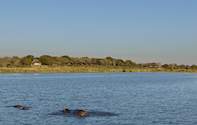
With the seemingly inevitable loss of the Olifants River gorge to the raising of the Massingir Dam wall in Mozambique, the Kruger National Park (KNP) has one last remaining unspoilt gorge left on a perennial river, and this pristine gorge is increasingly coming under threat from the proposed raising of another damwall in Mozambique. The Sabie River gorge in the southern section of the Lebombo Mountains is unique in both the Kruger Park and the entire Sabie River system.
For many years a sword of doom has been hovering over the valley and its unique combination of biodiversity in the form of the Corumana Dam, located in the Moamba district of the Maputo province of Mozambique. When construction on the Corumana Dam stopped in 1989, the Mozambicans had not raised the dam wall to its intended full supply level, and the dam waters did not reach back into Kruger, sparing the Sabie Valley.
However, the Mozambicans have never put away their plans to raise the dam wall and install crest gates, and with the help of a US$14.6 million World Bank loan to fund water resources management in Mozambique, they have been rehabilitating the Corumana dam and have also recently completed a feasibility study on raising the dam wall.
Two Kilometres Of The Sabie River Will Be Flooded In Kruger
About two kilometres of the Sabie River will be flooded in Kruger if the dam wall is raised, drowning a unique water berry forest and a number of plant species that only occur in that section of Kruger. The river will also lose its pool-rapid system, a type of river flow where bodies of clear, calm water end in the water spilling over rocks.
These sections of the river are of major importance for fish and crocodile life in the river, and the loss of these in the Sabie coupled with the loss of the pool-rapid system in the Olifants Gorge as a result of raising the Massingir Dam will have unhappy consequences for South Africa's aquatic biodiversity. Raising the Corumana Dam will also increase the amount of siltation in the Sabie River in Kruger.
An Irreplaceable Ecosystem Will Be Lost
The Wits University Centre for Water and the Environment has been running a series of research projects on the Sabie River since the 2000 floods. Head of the centre, Prof Kevin Rogers, says that if the Corumana Dam wall is raised, "an entirely unique" and "irreplaceable" ecosystem will be lost, and Sanparks will not be fulfilling its mandate to preserve biodiversity.
Along with the World Bank feasibility report on raising the Corumana Dam wall, there are also reports in other media that the committee for facilitation of agriculture between Mozambique and South Africa has plans (reportedly valued at R3.7 billion) to use water from the Corumana dam to irrigate 29,000ha of land to grow sugar cane for ethanol production. By increasing the height of the Corumana Dam wall, this will further facilitate this agricultural development and provide jobs in Mozambique.
International Agreement
The Sabie River forms part of the Inkomati and Maputo river catchments, and so is subject to an international agreement between South Africa, Mozambique and Swaziland. The raising of the Corumana Dam was recognised in the three countries' 2002 Tripartite Agreement as a potential project, but in terms of the agreement and SADC protocols Mozambique is supposed to give "timely no tification" if it intends to go ahead. Mozambique is also supposed to supply the other nations with "all available technical data and information as well as the results of any environmental impact assessment" for proposed projects.
According to Niel van Wyk, chief engineer for national water resources (eastern region) from the department of water affairs, who attends the Tripartite Permanent Technical Committee meetings, at the end of last year the Mozambicans handed out some promotional material at one of the meetings that listed raising the Corumana Dam as one of three intended projects. However, van Wyk says that this was "not sufficient information" to judge the project's impacts or the proposed timeframe.
Past experience with the Massingir Dam has revealed flaws in the communications between South Africa and Mozambique when it comes to projects of this nature, and it is not impossible that plans are much further advanced than the South African tripartite committee is aware of, especially in view of the massive irrigation project that has been approved.
On the flip side of this is the fact that Mozambique is totally reliant on neighbouring countries like South Africa for the water in its rivers, as none of its major rivers rise in the country. While Mozambique was busy fighting wars and its economy was stagnating, development continued in South Africa that severely reduced water flows into Mozambique, and today Mozambique is still not always supplied by South Africa with the water it is legally entitled to in terms of the international agreements.
By Melissa Wray
In Kruger National Park

